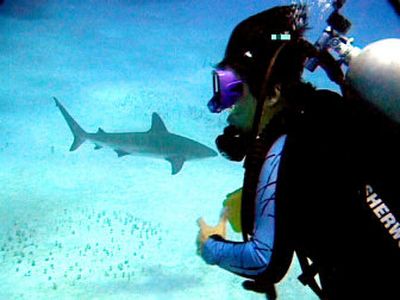Sharks flee new repellent

BIMINI, Bahamas – For years, people have been searching for a chemical substance that repels sharks.
During World War II, the U.S. Navy created “Shark Chaser,” a mixture of copper acetate and black dye made to smell like a rotting shark; scientists later determined it was ineffective.
In 1972, University of Maryland professor Eugenie Clark determined that a fish swimming in the Red Sea, known as the Moses sole, secreted a natural shark repellent. Researchers including the University of Miami’s Samuel Gruber and a team of Israeli and Egyptian scientists worked on replicating the milky liquid but gave up once they realized it worked only when injected directly into a shark’s mouth.
The Navy remained intent upon finding a solution, however, especially once sharks began their “million-dollar bite”: snapping acoustic lines that U.S. submarine operators towed underwater to eavesdrop on Russian operations.
Now, an American inventor believes he has grasped it. Eric Stroud, a research chemist who heads the Oak Ridge, N.J.-based company Shark Defense, comes to Bimini to test a chemical substance he believes will drive sharks away from dangerous fishing lines and, perhaps, also protect people. Working with Gruber, who directs the Bimini Biological Field Station, a shark-research facility, Stroud has determined that a synthetic liquid replicating the scent of rotting sharks prompts them to flee when it is released into the water.
Stroud, who used to work for pharmaceutical companies, entered the scene after the “summer of the shark” in 2001, when the national media were riveted on a series of 50 shark attacks off U.S. coasts.
In the spring of 2003, Stroud came to Bimini to test his formula – a combination of a dozen compounds known as A2 – on the shark species that thrive in the area, including blacknose, bull, Caribbean reef, lemon, nurse and tiger sharks. “We were thinking of saving the sharks first, and the human product came afterwards,” Stroud said.
Stroud – who hopes to launch his first commercial product early next year, in the form of a time-released device fishermen can attach to their longlines so sharks do not become tangled in them – now spends his time fielding calls from lifeguards, surfers and other water sports enthusiasts hoping to avert catastrophe.
The number of shark attacks off U.S. coasts has risen over time, as more people have flocked to the water. In late June, doctors amputated the leg of a 16-year-old boy attacked by a shark while fishing off the Florida Panhandle two days after a shark killed a teenage girl at another beach 80 miles away.
U.S. shark attacks rose from 18 in 1990 to 52 in 2000, before dropping to 30 last year, according to the International Shark Attack File at Florida’s Museum of Natural History. George Burgess, who directs the museum’s Florida program for shark research, estimated that, worldwide, sharks kill five to seven people a year.
It takes less than a pint of Stroud’s repellent, which smells slightly sweet, to scare off a group of sharks. “They just have to get a whiff of it, that’s all,” said Michael Herrmann, Stroud’s business partner and an electrical engineer by training.
Stroud has successfully tested the substance on tuna in Panama to make sure they will approach fishing lines despite the repellent, because fishermen will not use it if it scares off commercially targeted species.